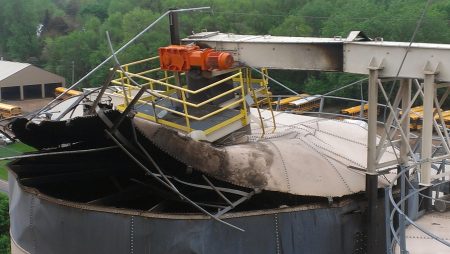4 Equipment Safeguards That Can Minimize Your Explosion Risk
It should come as no surprise that fires and explosions cost companies billions of dollars each year.
Lost productivity, the cost of repairing or replacing damaged or destroyed equipment, settling lawsuits originating from employee injuries or deaths – it all contributes to the total.
Industrial operations that handle materials such as grain, sulfur, oil and gas, biomass, and wood pellets are particularly familiar with the dangers of explosions. Two recent incidents at a corn processing plant in Cambria, Wisconsin, and a fertilizer and farm equipment facility in Detroit, Maine, serve as sobering reminders of the significant financial and human costs associated with industrial explosions.
 These and countless other incidents can be mitigated or eliminated entirely in a variety of ways – starting with a simple conversation or consultation early in the equipment selection process. At CDM, we know the potential for explosion exists when handling all of the materials mentioned earlier, as well as others. That knowledge will prompt us to ask certain questions in order to collect the required data for proper equipment selection.
These and countless other incidents can be mitigated or eliminated entirely in a variety of ways – starting with a simple conversation or consultation early in the equipment selection process. At CDM, we know the potential for explosion exists when handling all of the materials mentioned earlier, as well as others. That knowledge will prompt us to ask certain questions in order to collect the required data for proper equipment selection.
However, customers must remember that it is their responsibility to inform us about the material they’re dealing with – and to make it clear they need a plan for mitigating the potential for explosion. Often the most important information regarding the explosive properties of a particular material (or more accurately, the dust it creates) is revealed through third-party testing, which must be commissioned by the customer. This testing will eliminate any guessing or doubt about any potential dangers that could occur during the material handling process.
Once this information has been obtained and shared with us, we can pick up the proverbial ball and run with it. There are four common safeguards we can implement on our conveyors to help prevent explosions from occurring in the first place, or at least minimize the damage if they do happen:
- Explosion venting provides relief for the pressure a fire or explosion causes within a conveyor. Without proper venting, the equipment acts as a plenum or chimney and moves the volatility downstream, where a more catastrophic explosion could occur. This is a relatively economical way to account for the potential for explosions. In fact, National Fire Protection Association (NFPA) standards mandate this safeguard when handling certain materials.
- Nitrogen purging will make a conveyor inert by limiting the amount of oxygen within the equipment. This prevents the conveyor from reacting with hydrocarbons and creating explosive mixtures.
- Adding lifting/grounding lugs to conveyors can mitigate the potential for static electricity to start an arc or create a spark, two of the most common causes of industrial explosions.
- Using plastic or synthetic ultra-high-molecular-weight (UHMW) paddles to move material through the conveyor also reduces the possibility of sparks by eliminating steel-to-steel contact within the equipment.
Ultimately, none of these options can deliver the necessary benefit without open communication between customer and manufacturer. With some materials, the risk of explosion isn’t obvious. That’s when full disclosure about material properties is absolutely essential, which stresses the importance of establishing a true partnership instead of treating the relationship as a simple business transaction.
There are many challenges associated with conveying bulk materials. At the very top of the list is understanding the properties of those materials and how they interact with each other, as well as how they interact with all of the environmental factors in a given operation. Equipment is one of those factors, and like all suppliers, CDM must adhere to a strict set of industry-standard guidelines for fire prevention and explosion mitigation when designing a proposed solution.
But even those guidelines can’t account for everything a conveyor might encounter in a specific application. That’s why, with every customer and every project, CDM strives for the highest levels of trust and transparency to avoid catastrophic consequences and unimaginable losses.
———
About CDM
The CDM story is about recognizing every industrial operation is different, as are their conveying challenges. A custom-engineered conveying system is a cost-effective approach to any operation willing to look at the value of having a partner who is vested in your success and one who stands by their product. CDM has earned more than 91 percent repeat business because we’re more than just a conveying systems manufacturer – we’re a business partner.
For further information contact:
Andrew Parker, President CDM Systems, Inc.
Browse By Benefit
Categories
- Blog (40)
- Case Studies (9)
- News (7)
- Product Information (7)
- Tech Briefs (3)
- Technical Documents (33)
- Uncategorized (1)
- Videos (12)
- White Papers (5)

